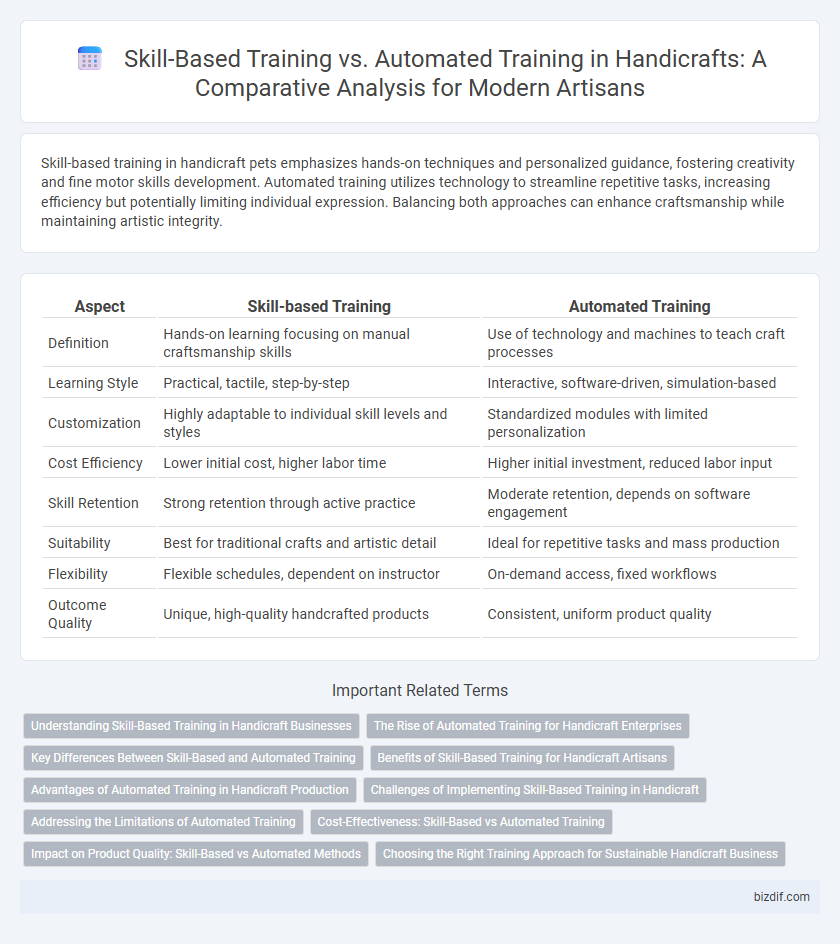Skill-based training in handicraft pets emphasizes hands-on techniques and personalized guidance, fostering creativity and fine motor skills development. Automated training utilizes technology to streamline repetitive tasks, increasing efficiency but potentially limiting individual expression. Balancing both approaches can enhance craftsmanship while maintaining artistic integrity.
Table of Comparison
| Aspect | Skill-based Training | Automated Training |
|---|---|---|
| Definition | Hands-on learning focusing on manual craftsmanship skills | Use of technology and machines to teach craft processes |
| Learning Style | Practical, tactile, step-by-step | Interactive, software-driven, simulation-based |
| Customization | Highly adaptable to individual skill levels and styles | Standardized modules with limited personalization |
| Cost Efficiency | Lower initial cost, higher labor time | Higher initial investment, reduced labor input |
| Skill Retention | Strong retention through active practice | Moderate retention, depends on software engagement |
| Suitability | Best for traditional crafts and artistic detail | Ideal for repetitive tasks and mass production |
| Flexibility | Flexible schedules, dependent on instructor | On-demand access, fixed workflows |
| Outcome Quality | Unique, high-quality handcrafted products | Consistent, uniform product quality |
Understanding Skill-Based Training in Handicraft Businesses
Skill-based training in handicraft businesses emphasizes hands-on experience and mastery of traditional techniques, fostering creativity and attention to detail unique to each artisan. This form of training enhances craftsmanship quality by allowing artisans to develop personalized skills that automated systems cannot replicate. Deep understanding of materials, tools, and cultural significance is cultivated through mentorship and practice rather than automation.
The Rise of Automated Training for Handicraft Enterprises
Automated training platforms revolutionize handicraft enterprises by offering scalable, consistent skill development through AI-driven modules and virtual simulations. These technologies reduce the dependency on traditional skill-based workshops, accelerating proficiency acquisition while maintaining quality standards. Integration of automated training tools enables artisans to adapt swiftly to evolving market demands and enhance production efficiency.
Key Differences Between Skill-Based and Automated Training
Skill-based training in handicraft emphasizes hands-on experience and manual dexterity development, fostering creativity and personalized craftsmanship. Automated training leverages technology and machinery to streamline production, ensuring consistency and efficiency but often reducing the artisanal touch. Key differences include the depth of human involvement, the level of customization possible, and the balance between tradition and modern efficiency.
Benefits of Skill-Based Training for Handicraft Artisans
Skill-based training for handicraft artisans enhances fine motor skills, creativity, and cultural knowledge essential for producing unique, high-quality products. This hands-on approach fosters deeper craftsmanship expertise, enabling artisans to adapt traditional techniques to modern market demands. Personalized mentorship and practice ensure skills are preserved and passed on, supporting sustainable livelihoods and community heritage.
Advantages of Automated Training in Handicraft Production
Automated training in handicraft production accelerates skill acquisition by providing consistent, repeatable instruction through digital platforms and virtual simulations, reducing human error and variability. It enhances scalability, allowing numerous artisans to access standardized training materials simultaneously, improving overall productivity and quality. Integration of AI-driven feedback systems enables real-time performance analysis, promoting continuous improvement and precision in handcrafted products.
Challenges of Implementing Skill-Based Training in Handicraft
Implementing skill-based training in handicraft faces challenges such as the need for personalized instruction and hands-on practice, which demand significant time and expert availability. Limited access to skilled trainers and resources in rural or remote areas further complicates effective training delivery. Additionally, maintaining traditional craftsmanship quality while scaling training efforts presents difficulties in standardization and assessment.
Addressing the Limitations of Automated Training
Skill-based training in handicrafts emphasizes hands-on experience and manual dexterity, which automated training often lacks due to its reliance on standardized processes and algorithms. Automated training struggles to replicate the nuanced tactile feedback and creative adaptability essential for mastering intricate handicraft techniques. Incorporating skill-based approaches supplements automated methods by fostering critical thinking and personalized craftsmanship development.
Cost-Effectiveness: Skill-Based vs Automated Training
Skill-based training in handicrafts often proves more cost-effective due to lower initial investment and the ability to customize learning for individual artisans. Automated training requires substantial upfront costs for technology and software but can reduce long-term expenses by standardizing processes and minimizing human error. Small-scale handicraft businesses benefit from skill-based methods, while larger enterprises may find automated training economically viable through scalability and efficiency.
Impact on Product Quality: Skill-Based vs Automated Methods
Skill-based training enhances artisans' dexterity and creativity, resulting in unique, high-quality handcrafted products with intricate details and cultural authenticity. Automated training promotes consistency, precision, and increased production speed, but may lack the nuanced craftsmanship that defines traditional handiwork. Balancing both methods can optimize product quality by integrating artisan expertise with technological efficiency.
Choosing the Right Training Approach for Sustainable Handicraft Business
Skill-based training in handicrafts enhances artisans' creativity, fine motor skills, and cultural craftsmanship, fostering unique, high-quality products that appeal to niche markets. Automated training streamlines production, increases efficiency, and reduces operational costs, benefiting mass production and meeting large-scale demand. Selecting the right approach depends on balancing handcrafted authenticity with scalability to ensure long-term sustainability in the handicraft business.
Skill-based Training vs Automated Training Infographic

 bizdif.com
bizdif.com